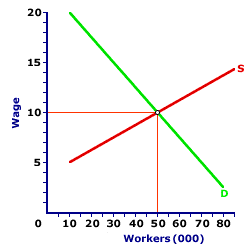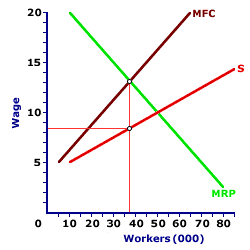Introduction
Minimum wage is the lowest pay that an employee should get per hour, per day or per month. These earnings are usually set by the government through legislation; however, two arguments, social and fiscal, are usually presented concerning the issue of minimum wage.
Minimum wage laws usually cover employees who work in the fields of employment with low pay, and are usually imposed to raise the wages to reduce exploitation of the employees by their employers. Governments usually impose minimum wage to reduce poverty; indeed, increase in the minimum wage is also said to increase motivation of the workers and hence lead to more productivity.
However, some economic analysts believe that raising the minimum wage does not reduce poverty, arguing that it in fact increases the levels of poverty since it creates unemployment. These people also argue that increase in the minimum wage hurts small firms severely as they usually try to minimize on their cost of production to maximize on their returns as they continue to grow.
This may usually make the firms to reduce their workforce, and the remaining workforce is usually overworked to compensate for the reduced workforce. These people also believe that minimum wage causes inflation, as organizations tend to increase the cost of their product to cater for the increased cost of production due to the increase.
Theory of minimum wage
Usually, there are theories proposed to explain the effects of minimum wage on the employment. The standard neoclassical theory explains that the availability of labour and employment follow an equilibrium demand supply curve with the downward sloping demand curve for labour and the upward sloping supply curve for labour.
The point of intersection between the downward sloping demand curve and the upward sloping supply is the equilibrium point (Atanova, Tudoreanu and St.Lawrence University 70). This is the equilibrium wage, which the market is capable of offering for labour.
Therefore, if the government imposes a minimum wage lower than the equilibrium wage, this would have no effect since equilibrium wage will be higher than the minimum wage. However, by imposing legislation, which demands, that the minimum wage be higher than the equilibrium wage, this forces the minimum wage from being pushed downwards due to market forces.
However, this creates disequilibrium in the labour supply demand curve with the supply of labour being more than the demand for it by the market. This leads to unemployment as some people will not get work for their skills; indeed, unemployed people are usually worse of than before the minimum wage since they will now have zero income.

However, increase in minimum wage higher than the equilibrium wage does not always result in unemployment. An example is usually explained in Monopsony, a situation where there is only one employer in the labour market. In this situation, the factors that are explained in neoclassical theory do not necessary hold.
In fact, minimum wage significantly influences the direction of employment in the economy as well as eliminating the shortcomings of Monopsony, thus in this situation, the cost of hiring additional workers follows an upward sloping curve, which is usually above the labour supply.

MRP represents the marginal revenue product curve, which is identical to the market demand curve in standard neoclassic market. MFC represents the marginal cost curve which is the cost incurred by a Monopsonistic firm in hiring a new employee. S represents the factor supply curve identical to the competitive market.
In some instances, raising the minimum wage increases the demand of the product produced by the company. This will therefore make the company to hire more workers in order to increase output to cater for increased demand. This may occur if the workers are also consumers of the product; hence, increasing their wage enables them to buy more of the product.
Analysis of the effects of minimum wage
The labour market rarely fits the characteristics of the ideal standard neoclassical theory or of Monopsony. Therefore, generalization is generally used to explain the effects of minimum wage on employment and poverty levels. Many economists have different views regarding the effects of increasing the minimum wage.
This is because the labour market does not fit the ideal neoclassical situation or the Monopsony situation. Increase in the minimum wage does not necessary lead to loss of employment. Many different states in the United States have not reduced the number of employed people after increasing their minimum wage; a notable example is New Jersey and Pennsylvania.
Increase in minimum wage in these states in 1988 did not lead to reduction of the people employed; in fact, it led to increase in the employment as shown in their data. For instance, the increase in the minimum wage of Vermont and Illinois in January 2006 from $7.0 to 7.25 has been used to show the effects of increasing the minimum wage on employment (Atanova, Tudoreanu and St.Lawrence University 72).
In Vermont, it led to a decrease in the number of people who were employed. However, analysis of the data showed that it was not reliable as there were very many other factors, which affected employment. However, their increase had no effect on employment in Illinois. These are a few examples to show that increase in the minimum wage does not lead to reduced employment.
The argument that increase in the minimum wage usually leads to unemployment is usually viewed differently by different people who have vested interests.
Businesspersons and generally entrepreneurs are usually opposed to increase in minimum wage as it leads to an increase in their cost of production. This is because each entrepreneur usually strives to reduce the cost of production in order to maximize on his or her profits. Labour unions would like to portray the increase in minimum wage as of not having adverse effects on employment.
This is because by showing that it reduces employment they would show that it reduces their members by making them loose employment. Therefore, the debate on minimum wage is usually a passionate one as each group would like to portray the other as being on the wrong. These groups may use many different methods to prove their correctness, sometimes even overlooking some factors while analyzing their data.
Minimum wage does not necessarily lead to inflation since the costs of labour in most organizations does not usually account for a large percentage of overall expenses. Increase in the minimum wage cannot be directly related to the loss of employment, as there are many other political and economic factors, which usually affect employment.
It is clear that both theories are based upon ideal situations. However ideal situation rarely do not occur. Therefore, it would be hard to single out increase in the levels of unemployment due minimum wage increase. Form the above two theories it is clear that markets cannot be left to self regulate themselves especially in third world countries so as to reduce their levels of poverty.
Conclusion
The issue of minimum wage is mainly a political one. Governments usually increase minimum wages at a rate lower than the rates of inflation in order to reduce the powers labour unions have on the powers. However, minimum wage should be increased from time to time to cater for inflation and reduce the levels of poverty.
Works Cited
Atanova, Stefka, Tudoreanu, Mihnea and St.Lawrence University. “The Effects of a Raised Minimum Wage on Employment: Differences across States and Social Groups.” Issues in Political Economy, Vol. 19, pp 69-89. 2009. Web.